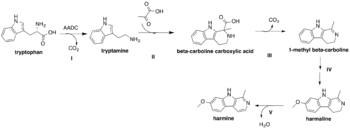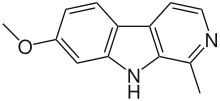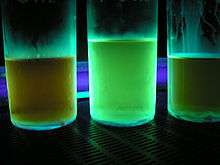Harmine
Harmine, also known as banisterine and as telepathine, a fluorescent harmala alkaloid belonging to the beta-carboline family of compounds. It occurs in a number of different plants, most notably the Middle Eastern plant harmal or Syrian rue (Peganum harmala) and the South American vine Banisteriopsis caapi (also known as "yage" or "ayahuasca"). Harmine reversibly inhibits monoamine oxidase A (MAO-A), an enzyme which breaks down monoamines, making it a RIMA. Harmine selectively binds to MAO-A but does not inhibit the variant MAO-B.[3]
| |||
| Names | |||
|---|---|---|---|
| IUPAC name
7-Methoxy-1-methyl-9H | |||
| Identifiers | |||
3D model (JSmol) |
|||
| ChEBI | |||
| ChEMBL | |||
| ChemSpider | |||
| DrugBank | |||
| ECHA InfoCard | 100.006.485 | ||
| KEGG | |||
PubChem CID |
|||
| UNII | |||
CompTox Dashboard (EPA) |
|||
| |||
| |||
| Properties | |||
| C13H12N2O | |||
| Molar mass | 212.25 g/mol | ||
| Melting point | 321 °C (610 °F; 594 K) (·HCl); 262 °C (·HCl·2H2O)[1] | ||
| insoluble[2] | |||
| Solubility in Dimethyl sulfoxide | 100mM[2] | ||
| Solubility in Ethanol | 1 mg/mL[2] | ||
Except where otherwise noted, data are given for materials in their standard state (at 25 °C [77 °F], 100 kPa). | |||
| Infobox references | |||
Biosynthesis
Isolated from the plant Peganum harmala, harmine is an indole alkaloid with the pyrido[3,4-b]indole ring structure that is characteristic of the β-carboline alkaloids. The β-carboline alkaloids include harmine, harmaline, harman and harmalol. These molecules are heterocyclic amines, biosynthesized through the combination of five- and six-membered ring structures that are derived from an amino acid (either L-tryptophan or tryptamine), which facilitates the formation of an indole ring system.[4]
The coincident occurrence of β-carboline alkaloids and serotonin in P. harmala indicates the presence of two very similar, interrelated biosynthetic pathways, which makes it difficult to definitively identify whether free tryptamine or L-tryptophan is the precursor in the biosynthesis of harmine.[5] However, it is postulated that L-tryptophan is the most likely precursor, with tryptamine existing as an intermediate in the pathway.
The following figure shows the proposed biosynthetic scheme for harmine.[6] The Shikimate acid pathway yields the aromatic amino acid, L-tryptophan. Decarboxylation of L-tryptophan by aromatic L-amino acid decarboxylase (AADC) produces tryptamine (I), which contains a nucleophilic center at the C-2 carbon of the indole ring due to the adjacent nitrogen atom that enables the participation in a mannich-type reaction. Rearrangements enable the formation of a Schiff base from tryptamine, which then reacts with pyruvate in II to form a β-carboline carboxylic acid. The β-carboline carboxylic acid subsequently undergoes decarboxylation to produce 1-methyl β-carboline III. Hydroxylation followed by methylation in IV yields harmaline. The order of O-methylation and hydroxylation have been shown to be inconsequential to the formation of the harmaline intermediate.[5] In the last step V, the oxidation of harmaline is accompanied by the loss of water and effectively generates harmine.

The difficulty distinguishing between L-tryptophan and free tryptamine as the precursor of harmine biosynthesis originates from the presence of the serotonin biosynthetic pathway, which closely resembles that of harmine, yet necessitates the availability of free tryptamine as its precursor.[5] As such, it is unclear if the decarboxylation of L-tryptophan, or the incorporation of pyruvate into the basic tryptamine structure is the first step of harmine biosynthesis. However, feeding experiments involving the feeding of one of tryptamine to hairy root cultures of P. harmala showed that the feeding of tryptamine yielded a great increase in serotonin levels with little to no effect on β-carboline levels, confirming that tryptamine is the precursor for serotonin, and indicating that it is likely only an intermediate in the biosynthesis of harmine; otherwise, comparable increases in harmine levels would have been observed.[6]
Uses
Monoamine Oxidase Inhibitor
Monoamines include neurotransmitters (serotonin, dopamine), hormones (melatonin, epinephrine, norepinephrine). By slowing the breakdown of neurotransmitters, monoamine oxidase inhibitors (MAOIs) can help to replenish the body's supply of these chemicals, and many MAOIs are used as antidepressants. Harmine has not been the subject of much clinical research in the treatment of depression, which could be due in part to its restricted legal status in many countries.
P. harmala and B. caapi are both traditionally used for their psychoactive effects. B. caapi has a tradition of use in conjunction with plants containing the drug DMT. Traditionally, B. caapi is consumed as a drink, with or without the DMT-bearing plants (see Ayahuasca). Ordinarily, DMT is not active when taken orally, but users report very different effects when MAOIs are present in such beverages. Harmine and substances containing it have been used in conjunction with many other drugs by modern experimenters. Many hallucinogens appear to exhibit increased potency when used in this way.
Harmine is also a useful fluorescent pH indicator. As the pH of its local environment increases, the fluorescence emission of harmine decreases.
With the radioisotope carbon-11 harmine is used in positron emission tomography neuroimaging to examine its competitive binding to MAO-A.[7]
Harmine found in root secretions of Oxalis tuberosa has been found to have insecticidal properties.[8]
Harmine has been found to increase EAAT2 glutamate pump expression in central nervous system, therefore reducing glutamate toxicity.[9]
Anti-cancer
"Harmine showed cytotoxicity against HL60 and K562 cell lines. This could explain the cytotoxic effect of P. harmala on these cells."[10]
Effects on bone and cartilage
"Harmine was shown to promote differentiation of osteoblasts (bone-forming cells),[11] and chondrocytes (cells in the cartilage)."[12]
It was also shown to inhibit osteoclastogenesis (the formation of bone resorbing cells)[13]
Pancreatic islet cell proliferation
Harmine is currently the only known drug that induces proliferation (rapid mitosis and subsequent mass growth) of pancreatic alpha (α) and beta (β) cells in adult humans. These islet sub-cells are normally very resistant to growth stimulation in the adult stage of a human's life, as the cell mass plateaus at around age 10 and remains virtually unchanged from there on. Other similar drugs have been successful in triggering beta cell proliferation in rats/mice and pigs, however these drugs were met with very limited to no success in human subjects. Harmine was found to increase the diminished beta cell mass of diabetic people to clinically significant levels for a short time: this property proves very useful in a possible harmine-based treatment for both Type 1 and Type 2 Diabetes.
Harmine is known to be a potent inhibitor of the DYRK1A enzyme pathway. This is thought to be the main mechanism by which harmine can induce alpha and beta cell proliferation in vivo. DYRK1A is an enzyme that plays a definitive role in suppressing/regulating cell proliferation, therefore it makes sense that the partial blocking of DYRK1A increases the growth of certain cells, including pancreatic α and β cells. The alteration of many other enzymes and genes that are implicated in cell proliferation have shown no significant results in humans, hence it is still unknown why DYRK1A inhibition specifically can force α and β cells to divide and grow, in humans no less.
Adverse effects
Harmine, and plants containing significant amounts of harmine and other harmala alkaloids are generally not considered safe treatments for depression within the medical community. This bias however is primarily built on previous decades of experience with pharmaceutical non-specific MAOIs that block both MAO-A and MAO-B.[14]
It has recently been shown in the Journal of Photochemistry and Photobiology B: Biology that beta-carboline MAO inhibitors, such as harmine, bind with DNA and also exhibit anti-tumor properties. Harmine has been shown to bind one hundred times more effectively than its close analogue harmaline. The consequences of this are currently not well understood.[15]
Rapid discontinuation of MAO inhibitors can cause serious withdrawal syndrome.
Overdosage
Oral or intravenous harmine doses ranging from 30–300 mg may cause agitation, bradycardia or tachycardia, blurred vision, hypotension, paresthesias. Serum or plasma harmine concentrations may be measured as a confirmation of diagnosis. The plasma elimination half-life is on the order of 1–3 hours.[16]
Natural sources
Harmine is found in a wide variety of different organisms, most of which are plants. Alexander Shulgin[17] lists about thirty different species known to contain harmine, including seven species of butterfly in the family Nymphalidae. The harmine-containing plants listed include tobacco, Peganum harmala, two species of passiflora, and numerous others. Lemon balm (Melissa officinalis) contains harmine.[18]
In addition to B. caapi, at least three members of the Malpighiaceae contain harmine, including two more Banisteriopsis species and the plant Callaeum antifebrile. Callaway, Brito and Neves (2005)[19] found harmine levels of 0.31-8.43% in B. caapi samples.
The family Zygophyllaceae, which P. harmala belongs to, contains at least two other harmine-bearing plants: Peganum nigellastrum and Zygophyllum fabago.
Legal status
Australia
Harmala alkaloids are considered Schedule 9 prohibited substances under the Poisons Standard (October 2015).[20] A Schedule 9 substance is a substance which may be abused or misused, the manufacture, possession, sale or use of which should be prohibited by law except when required for medical or scientific research, or for analytical, teaching or training purposes with approval of Commonwealth and/or State or Territory Health Authorities.[20]
Exceptions are made when in herbs, or preparations, for therapeutic use such as: (a) containing 0.1 per cent or less of harmala alkaloids; or (b) in divided preparations containing 2 mg or less of harmala alkaloids per recommended daily dose.[20]
See also
References
- The Merck Index (1996). 12th edition
- "Harmine - CAS 442-51-3". scbio.de. Santa Cruz Biotechnology, Inc. Retrieved 27 October 2015.
- "Abstract Gerardy J, "Effect of moclobemide on rat brain monoamine oxidase A and B: comparison with harmaline and clorgyline.", Department of Pharmacology, University of Liège, Sart Tilman, Belgium". Archived from the original on 2011-05-26. Retrieved 2007-08-16.
- Wernicke, Catrin, and Jochen Lehmann. "Beta-Carbolines: Occurrence, Biosynthesis, and Biodegredation." By Hans Rommelspacher.
- Berlin Jochen; Rugenhagen Christiane; Greidziak Norbert; Kuzovkina Inna; Witte Ludger; Wray Victor (1993). "Biosynthesis of Serotonin and Beta-carboline Alkaloids in Hairy Root Cultures of Peganum Harmala". Phytochemistry. 33 (3): 593–97. doi:10.1016/0031-9422(93)85453-x.
- Nettleship Lesley; Slaytor Michael (1974). "Limitations of Feeding Experiments in Studying Alkaloid Biosynthesis in Peganum Harmala Callus Cultures". Phytochemistry. 13 (4): 735–42. doi:10.1016/s0031-9422(00)91406-7.
- Nathalie Ginovart; Jeffrey H. Meyer; Anahita Boovariwala; Doug Hussey; Eugenii A. Rabiner; Sylvain Houle; Alan A. Wilson (2006). "Positron emission tomography quantification of [11C]-harmine binding to monoamine oxidase-A in the human brain". Journal of Cerebral Blood Flow & Metabolism. 26 (3): 330–344. doi:10.1038/sj.jcbfm.9600197. PMID 16079787.
- Pal Bais, Harsh; Park, Sang-Wook; Stermitz, Frank R.; Halligan, Kathleen M.; Vivanco, Jorge M. (18 June 2002). "Exudation of fluorescent β-carbolines from Oxalis tuberosa L. roots" (PDF). Phytochemistry. 61 (5): 539–543. doi:10.1016/S0031-9422(02)00235-2. PMID 12409020. Archived from the original (PDF) on 5 September 2008. Retrieved 2008-02-02.
- Li Y; Sattler R; Yang EJ; Nunes A; Ayukawa Y; Akhtar S; Ji G; Zhang PW; Rothstein JD. (18 June 2011). "Harmine, a natural beta-carboline alkaloid, upregulates astroglial glutamate transporter expression". Neuropharmacology. 60 (7–8): 1168–75. doi:10.1016/j.neuropharm.2010.10.016. PMC 3220934. PMID 21034752.
- Jahaniani, F; Ebrahimi, SA; Rahbar-Roshandel, N; Mahmoudian, M (July 2005). "Xanthomicrol is the main cytotoxic component of Dracocephalum kotschyii and a potential anti-cancer agent". Phytochemistry. 66 (13): 1581–92. doi:10.1016/j.phytochem.2005.04.035. PMID 15949825.
- Yonezawa T, Lee JW, Hibino A, Asai M, Hojo H, Cha BY, Teruya T, Nagai K, Chung UI, Yagasaki K, Woo JT (2011). "Harmine promotes osteoblast differentiation through bone morphogenetic protein signaling". Biochemical and Biophysical Research Communications. 409 (2): 260–265. doi:10.1016/j.bbrc.2011.05.001. PMID 21570953.
- Hara ES, Ono M, Kubota S, Sonoyama W, Oida Y, Hattori T, Nishida T, Furumatsu T, Ozaki T, Takigawa M, Kuboki T (2013). "Novel chondrogenic and chondroprotective effects of the natural compound harmine". Biochimie. 95 (2): 374–81. doi:10.1016/j.biochi.2012.10.016. PMID 23116713.
- Egusa H, Doi M, Saeki M, Fukuyasu S, Akashi Y, Yokota Y, Yatani H, Kamisaki Y (2011). "The small molecule harmine regulates NFATc1 and Id2 expression in osteoclast progenitor cells". Bone. 49 (2): 264–274. doi:10.1016/j.bone.2011.04.003. PMID 21504804.
- Eric Yarnell; Kathy Abascal (April 2001). "Botanical Treatments for Depression". Alternative & Complementary Therapies. 7 (3): 138–143. doi:10.1089/10762800151125056.
- Nafisi, Shohreh; Bonsaii, Mahyar; Maali, Pegah; Khalilzadeh, Mohammad Ali; Manouchehri, Firouzeh (2010). "β-Carboline alkaloids bind DNA". Journal of Photochemistry and Photobiology B: Biology. 100 (2): 84–91. doi:10.1016/j.jphotobiol.2010.05.005. PMID 20541950.
- R. Baselt, Disposition of Toxic Drugs and Chemicals in Man, 8th edition, Biomedical Publications, Foster City, CA, 2008, pp. 727-728.
- Shulgin, Alexander; Shulgin, Ann (1997). TiHKAL: The Continuation. Transform Press. ISBN 0-9630096-9-9. Pages 713–714
- Natalie Harrington (2012). "Harmala Alkaloids as Bee Signaling Chemicals". Journal of Student Research. 1 (1): 23–32.
- Callaway J. C.; Brito G. S.; Neves E. S. (2005). "Phytochemical analyses of Banisteriopsis caapi and Psychotria viridis". Journal of Psychoactive Drugs. 37 (2): 145–150. doi:10.1080/02791072.2005.10399795. PMID 16149327.
- Poisons Standard October 2015 https://www.comlaw.gov.au/Details/F2015L01534
External links
- Harmine found in Oxalis tuberosa
- Harmine entry in TiHKAL • info
- Brierley Daniel I., Davidson Colin (2012). "Developments in harmine pharmacology — Implications for ayahuasca use and drug-dependence treatment". Progress in Neuro-Psychopharmacology & Biological Psychiatry. 39 (2): 263–272. doi:10.1016/j.pnpbp.2012.06.001. PMID 22691716. Archived from the original on 2014-03-27.


